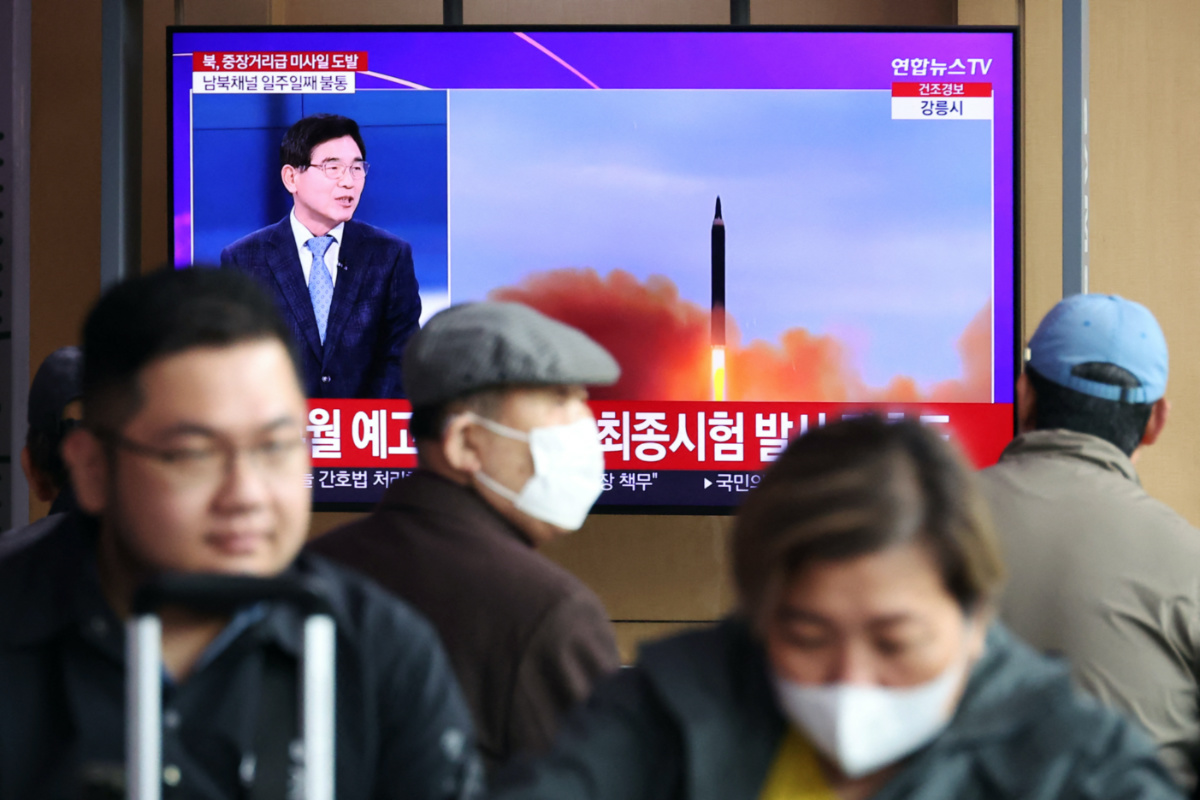Seoul, South Korea/Tokyo, Japan
Reuters
North Korea said on Friday it has tested a new solid-fuel intercontinental ballistic missile Hwasong-18 aimed at boosting the country’s nuclear counter-attack capability, state media reported.
North Korea fired what appeared to be a new model ballistic missile on Thursday, South Korea said, triggering a scare in northern Japan where Hokkaido residents were told to take cover, though there turned out to be no danger.

People watch a TV broadcasting a news report on North Korea firing a ballistic missile of intermediate range or longer, at a railway station in Seoul, South Korea, on 13th April, 2023. PICTURE: Reuters/Kim Hong-Ji
“The test proved…the new intercontinental ballistic missile’s military efficiency as a strategic attack capability,” news agency KCNA said, adding it will dramatically improve the country’s strategic deterrence and nuclear counterattack readiness.
Leader Kim Jong-un guided the test, KCNA said.
Developing a solid-fuel ICBM has long been seen as a key goal for North Korea, as it could help the North deploy its missiles faster in the event of a war.
The latest launch came days after North Korean leader Kim called for strengthening war deterrence in a “more practical and offensive” manner to counter what North Korea called moves of aggression by the United States.
North Korea has criticised recent US-South Korean joint military exercises as escalating tensions and has stepped weapons tests in recent months.
Earlier South Korea’s military said the missile flew about 1,000 kilometres, , calling it a “grave provocation”. The official said the missile’s maximum altitude was lower than 6,000 kilometres, the apogee of some of last year’s record-breaking tests.
The South Korean military said it was on high alert and coordinating closely with its main ally, the United States, which “strongly condemned” what the White House said was a long-range ballistic missile test.
UN Secretary-General Antonio Guterres also strongly condemned the test and called on North Korea to return to denuclearisation talks, his spokesman Stephane Dujarric said.
While condemning the latest in a string of North Korean missile tests, Washington renewed its offer to resume talks.
“The door has not closed on diplomacy, but Pyongyang must immediately cease its destabilising actions and instead choose diplomatic engagement,” US National Security Council spokesperson Adrienne Watson said.
Following the launch, the Japanese and US air forces conducted drills over the Sea of Japan “as the security environment surrounding Japan is becoming more and more severe,” Japan’s defence ministry said.
While North Korea has tested short-range solid-fuel missiles, it has not tested a long-range missile of that type, said Bruce Bennett, a senior defence analyst at the US-based RAND Corporation.
We rely on our readers to fund Sight's work - become a financial supporter today!
For more information, head to our Subscriber's page.
Kim Dong-yup, a former South Korean navy officer now at Kyungnam University, said the new system might have been an intercontinental ballistic missile that was unveiled at a February military parade, and powered by a solid-fuel engine tested in December.
James Acton, co-director of the Nuclear Policy Program at Washington’s Carnegie Endowment for International Peace, said he believed the United States would be able to determine between a solid- or liquid-fueled launch via early warning satellites capable of detecting differences in the infrared spectrums produced by different missile types.
“North Korea’s ongoing development of long-range solid-fueled missiles, which can be launched quicker, is significant by further complicating the challenges facing the US in attacking North Korea’s nuclear forces preemptively,” he said.
The missile was fired at 7:23am from near Pyongyang, the South’s military said. Japan’s coast guard said it had landed by 8:19am.
Brief panic
The nuclear envoys of South Korea, the US and Japan condemned the launch, saying Pyongyang had constantly threatened regional peace with “unprecedented levels of provocations and menacing words”, South Korea’s foreign ministry said.
Japan’s defence minister, Yasukazu Hamada, said the missile appeared to have been fired eastward at a high angle and did not fall in Japanese territory, but he could not confirm whether it had flown over Japan’s exclusive economic zone.
Japan’s coast guard said it had fallen in the sea east of North Korea.
Japanese authorities canceled an alert for the northern island of Hokkaido when they determined the missile would not fall nearby.
Schools in Hokkaido delayed opening and some train services were suspended.
A Hokkaido student told Japanese broadcaster NHK the alert caused momentary alarm at a train station.
“For a second in the train there was panic, but a station worker said to calm down, and people did,” the student said.
– With CHANG-RAN KIM in Tokyo, Japan, DAVID BRUNNSTROM in Washington DC, US, and MICHELLE NICHOLS at the United Nations.






